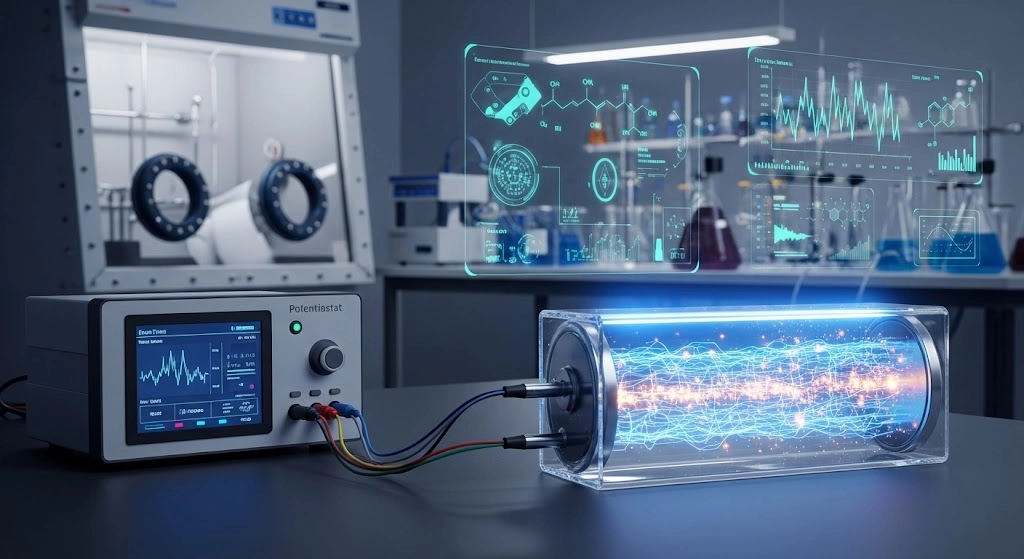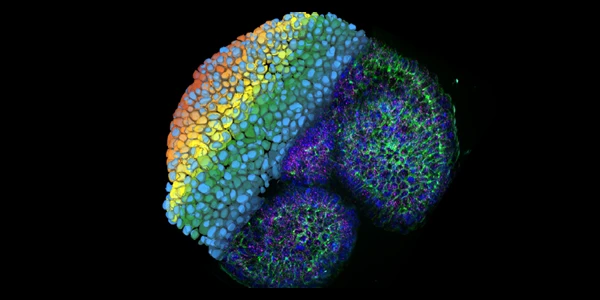In-Situ and Operando Electrochemistry: Using Potentiostats for Real-Time Battery Analysis

ImageFX (2025)
For laboratory professionals dedicated to advancing battery technology, the quest for deeper understanding goes beyond mere performance metrics. While traditional ex-situ analysis provides valuable post-mortem data, it often falls short of capturing the dynamic, intricate processes occurring within a battery during its operation. Imagine being able to observe, in real-time, the subtle chemical and physical transformations that dictate a battery's efficiency, lifespan, and safety. This is precisely the power of in-situ and operando electrochemistry, enabled by sophisticated potentiostats – tools that are rapidly becoming indispensable in modern battery research and development.
This article delves into the principles, techniques, and profound implications of applying in-situ and operando electrochemical methods to battery analysis. We will explore how potentiostats serve as the central nervous system for these experiments, providing the precision control and measurement capabilities required to unveil the hidden mechanisms of battery function and degradation, ultimately accelerating the path toward next-generation energy storage solutions.
In-Situ vs. Operando: Defining Real-Time Electrochemical Characterization for Batteries
Understanding the subtle yet crucial distinction between "in-situ" and "operando" is fundamental to appreciating their value in battery research. Both approaches aim to bridge the gap between theoretical models and real-world battery behavior, offering a direct window into the electrochemical reactions.
In-Situ Electrochemistry: This refers to measurements taken during the electrochemical process, but not necessarily under typical operating conditions. The battery system or a specific component is maintained in its electrochemical environment (e.g., electrolyte, controlled atmosphere), and measurements are performed without disassembling or altering the sample. The key here is maintaining the native environment of the sample. For example, studying electrode material swelling in an electrolyte while applying a potential, but not necessarily cycling the full battery.
Operando Electrochemistry: This is a more stringent subset of in-situ analysis. "Operando" implies measurements are taken under actual operating conditions of the device. For batteries, this means performing electrochemical measurements (e.g., charging and discharging) while simultaneously acquiring spectroscopic, structural, or microscopic data. The goal is to correlate the electrochemical performance directly with the underlying physical and chemical changes as they happen during a typical battery cycle. This provides the most direct insights into how a battery functions and degrades in real-time.
Why are these approaches critical? Traditional ex-situ analysis, where a battery is disassembled after operation, risks altering the very phenomena researchers wish to study. Reactive intermediates might disappear, structural changes might relax, or surface films might oxidize upon exposure to air. In-situ and operando techniques overcome these limitations by providing:
Direct Observation: Real-time monitoring of processes like solid-electrolyte interphase (SEI) formation, phase transitions, and active material degradation.
Mechanism Elucidation: Unraveling complex reaction pathways and identifying performance-limiting factors.
Accelerated Development: Faster identification of promising materials and designs by understanding their behavior under realistic conditions.
Potentiostats: Essential Tools for Precision Battery Electrochemistry
At the core of any in-situ or operando electrochemical experiment lies the potentiostat. This sophisticated electronic instrument is designed to control and measure the electrical variables (potential, current, charge) within an electrochemical cell with high precision and stability. Its ability to maintain a constant potential or current, or to sweep these parameters over time, makes it indispensable for probing battery dynamics.
Key Functions of a Potentiostat in Battery Research:
Potential Control: A potentiostat maintains a desired potential difference between the working electrode (where the reaction of interest occurs) and a reference electrode. This is crucial for techniques that rely on precise potential steps or sweeps.
Current Control (Galvanostat Mode): Conversely, in galvanostat mode, the instrument maintains a constant current flowing through the cell. This is essential for simulating charging/discharging cycles and for techniques like galvanostatic intermittent titration.
Impedance Measurement: Many modern potentiostats incorporate a frequency response analyzer (FRA) for Electrochemical Impedance Spectroscopy (EIS), allowing the study of resistance and capacitance within the battery at various frequencies.
Data Acquisition: High-speed data logging of current, potential, and charge over time, providing the raw data for analysis.
Integration with Ancillary Techniques: Potentiostats often serve as the central control unit, synchronizing electrochemical measurements with other analytical techniques (e.g., X-ray diffraction, Raman spectroscopy, mass spectrometry, microscopy) to enable true operando studies.
Components of a Potentiostat:
Control Amplifier: Applies the necessary voltage to maintain the desired potential or current.
Current-to-Voltage Converter: Measures the current flowing through the cell.
Reference Electrode Input: Monitors the potential of the reference electrode.
Counter Electrode Output: Completes the circuit, allowing current to flow.
The precision and versatility of modern potentiostats, including multi-channel systems for simultaneous testing of multiple cells, are what empower researchers to conduct the complex, multi-modal experiments required for advanced battery characterization.
Operando Battery Techniques: Unlocking Insights with EIS, CV, GITT, and PITT
Potentiostats enable a suite of electrochemical techniques that provide unique insights when applied in an operando fashion. Here are some of the most prominent:
1. Electrochemical Impedance Spectroscopy (EIS):
Principle: A small amplitude AC voltage (or current) is applied over a range of frequencies, and the resulting AC current (or voltage) is measured. The impedance (resistance to AC current) is then analyzed.
Operando Insight: EIS can differentiate between various resistive and capacitive elements within a battery, such as charge transfer resistance, ohmic resistance, and diffusion impedance. When performed operando, it allows monitoring of changes in these components during cycling, revealing insights into SEI growth, electrode degradation, and electrolyte stability.
Data Output: Nyquist plots (imaginary vs. real impedance) and Bode plots (impedance magnitude and phase angle vs. frequency).
2. Cyclic Voltammetry (CV):
Principle: The potential of the working electrode is swept linearly between two limits at a constant rate, and the resulting current is measured. The sweep direction is then reversed, completing a cycle.
Operando Insight: CV provides qualitative and quantitative information about redox reactions, reaction kinetics, and diffusion processes. Operando CV can identify phase transitions, active material utilization, and the formation of irreversible products during battery cycling.
Data Output: Current-potential curves with characteristic peaks corresponding to oxidation and reduction events.
3. Galvanostatic Intermittent Titration Technique (GITT) & Potentiostatic Intermittent Titration Technique (PITT):
Principle: These techniques involve applying a series of current pulses (GITT) or potential steps (PITT) separated by relaxation periods. During the relaxation, the open-circuit voltage (OCV) or current decay is monitored.
Operando Insight: GITT and PITT are powerful for determining thermodynamic and kinetic parameters, particularly the chemical diffusion coefficient of ions within electrode materials. Operando application allows researchers to track how these diffusion rates change with state of charge, cycling, and degradation.
Data Output: Potential vs. time (GITT) or current vs. time (PITT) curves, from which diffusion coefficients are calculated.
4. Galvanostatic Cycling (Charge/Discharge):
Principle: The battery is charged and discharged at a constant current (or C-rate) while monitoring the voltage profile over time.
Operando Insight: While seemingly basic, when coupled with operando spectroscopy or diffraction, galvanostatic cycling becomes a powerful tool. It provides the electrochemical context (e.g., specific state of charge, cycle number) during which other analytical data are collected, allowing direct correlation of structural/chemical changes with performance.
Data Output: Voltage vs. capacity/time curves.
Unveiling Battery Dynamics: Applications for Degradation Analysis & Performance Optimization
The integration of potentiostats with in-situ and operando techniques has revolutionized battery research, offering unprecedented insights into complex phenomena:
Solid-Electrolyte Interphase (SEI) Formation and Evolution: The SEI layer, formed on the anode surface during the first few cycles, is critical for battery stability but also a major source of capacity fade. Operando techniques can track its growth, composition changes, and impact on impedance in real-time.
Electrode Material Degradation: Observing structural changes, particle cracking, and active material dissolution as they occur during cycling helps to pinpoint degradation mechanisms and design more robust electrodes.
Phase Transitions: Many battery materials undergo phase changes during intercalation/deintercalation. Operando X-ray diffraction or Raman spectroscopy, synchronized with potentiostatic control, can identify these transitions and their impact on performance.
Electrolyte Decomposition: Real-time monitoring of gas evolution or changes in electrolyte composition using operando mass spectrometry or NMR can reveal parasitic reactions that consume electrolyte and contribute to capacity loss.
Thermal Management: Combining electrochemical measurements with in-situ thermal imaging provides insights into heat generation and dissipation during various operating conditions, crucial for battery safety and performance optimization.
Benefits for Laboratory Professionals:
Reduced Trial-and-Error: Faster identification of optimal materials and operating conditions.
Deeper Mechanistic Understanding: Moving beyond empirical observations to fundamental insights into battery behavior.
Improved Predictive Capabilities: Developing more accurate models for battery lifespan and performance.
Enhanced Safety: Identifying conditions that lead to thermal runaway or other safety concerns.
Accelerated Innovation: Bringing novel battery chemistries and designs to market more quickly.
Overcoming Challenges & Future Trends in Operando Battery Analysis
While immensely powerful, implementing in-situ and operando electrochemical experiments presents several challenges:
Complexity: Integrating multiple analytical techniques with electrochemical cells requires specialized expertise and sophisticated experimental setups.
Cell Design: Designing electrochemical cells that allow for simultaneous optical, X-ray, or other probes without compromising electrochemical performance is often challenging.
Data Handling: The sheer volume and complexity of multi-modal data generated require advanced data processing and analysis tools.
Cost: The specialized equipment and expertise can be a significant investment.
Despite these challenges, the future of in-situ and operando battery analysis is bright. Advances in miniaturization, automation, and data science, coupled with the development of new in-operando techniques (e.g., cryo-electron microscopy, advanced neutron scattering), promise to push the boundaries of what is observable within a working battery. As battery technology continues to evolve, these real-time analytical capabilities will remain at the forefront, driving the discovery and optimization of next-generation energy storage systems.
Conclusion: Powering Next-Generation Batteries with Operando Electrochemical Insights
In-situ and operando electrochemistry, powered by the precision of modern potentiostats, represents a paradigm shift in battery research. By enabling direct, real-time observation of the complex electrochemical and physicochemical processes occurring within a functioning battery, these techniques provide an unparalleled depth of understanding. For laboratory professionals, mastering these methodologies is no longer a luxury but a necessity for unraveling the mysteries of battery performance, mitigating degradation, and ultimately accelerating the development of safer, more efficient, and longer-lasting energy storage solutions that will power our future.
Frequently Asked Questions (FAQ)
Q1: What is the primary difference between in-situ and operando battery analysis? A1: In-situ analysis observes reactions within their native environment, while operando analysis specifically conducts these observations under actual device operating conditions (e.g., during charge/discharge cycles), providing direct correlation between performance and internal changes.
Q2: How do potentiostats contribute to real-time battery characterization? A2: Potentiostats are crucial for precisely controlling and measuring electrical parameters (potential, current, charge) within the battery cell, enabling various electrochemical techniques like EIS, CV, and GITT/PITT, which provide real-time insights into battery dynamics and degradation.
Q3: Which electrochemical techniques are commonly used for operando battery studies? A3: Key techniques include Electrochemical Impedance Spectroscopy (EIS) for resistance/capacitance changes, Cyclic Voltammetry (CV) for redox reactions and kinetics, and Galvanostatic/Potentiostatic Intermittent Titration Techniques (GITT/PITT) for ion diffusion coefficients, all performed while the battery is operating.
Q4: What are the main benefits of using in-situ/operando techniques in battery research? A4: These techniques provide direct observation of phenomena like SEI formation and electrode degradation, offer deeper mechanistic understanding, reduce trial-and-error in material development, improve predictive capabilities for battery lifespan, and enhance safety by identifying critical operating conditions.










